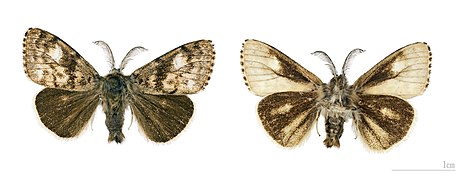Moonspot brush spinner
| Moonspot brush spinner | ||||||||||||
|---|---|---|---|---|---|---|---|---|---|---|---|---|

Moonspot brush spinner caterpillar ( Gynaephora selenitica ) |
||||||||||||
| Systematics | ||||||||||||
|
||||||||||||
| Scientific name | ||||||||||||
| Gynaephora selenitica | ||||||||||||
| ( Esper , 1789) |
The moon spot brush spinner or moon spot brush binder ( Gynaephora selenitica ) is a butterfly from the owl butterfly family (Noctuidae).
features
The males have an ocher yellow to light brown color and, like the darker front wings of the females, are strongly dotted with white to dark brown. There is usually a thin, light gray band on the lower edge of the wing. There is also a light gray, partially crescent-shaped spot on the forewing. The German-speaking, but also scientific name is derived from this spot. The dark brown, almost black hind wings are mostly without drawing. With a wingspan of 20–25 mm, the males are sometimes 10 mm smaller than the females with 30–35 mm. The antennae of the males are very pinnate, while those of the females are only slightly comb-toothed. There is a hairbrush on the female's abdomen, which she strokes over the green and rounded eggs.
The caterpillars are up to 35 mm long and black, with light to dark gray long hair. The five back brushes are white with a black base in the younger stages, later they turn yellowish-brown and gray.
The yellowish hairy pupa is reddish brown with dark wing sheaths. The cocoon is gray to gray-brown and mostly lies in sandy soils.
Similar species
The caterpillars of the gorse extensor ( Calliteara fascelina ) are easy to confuse with the caterpillars of the moonspot brush spinner. Specimens that can be found in autumn are mostly those of the moonspot brush moth, as the caterpillars of the gorse extensor ( Calliteara fascelina ) overwinter small, while those of the moonspot brush moth overwinter as a half-grown or even adult. Another possibility of differentiating the species is the range, because the gorse extensor foot, in contrast to the moonspot brush spinner, is distributed as far as southern Europe.
Way of life
The moths fly in one generation from early May to late June. While the males are diurnal, the females fly at night. The caterpillars overwinter in a burrow and can be found from late summer with a winter break until spring of the following year.
Caterpillar food
The caterpillars feed mainly on legumes (Fabaceae) like ...
- Snail clover ( Medicago )
- Crown vetch ( Coronilla )
- Horseshoe clover ( Hippocrepis )
- Esparsettes ( Onobrychis )
..., but also on other plants such as:
- Blackthorn ( Prunus spinosa )
- Willows ( Salix )
- Blueberries ( vaccinium )
- Common heather ( Calluna vulgaris )
- Raspberry ( Rubus idaeus )
- Cymbal herb ( Cymbalaria muralis )
Occurrence and distribution
The endangered species is common in Central Europe , Eastern Europe to the Urals . In South, West and North Europe the species occurs only sporadically or not at all. The species prefers rough grassland and dry meadows as a habitat , more rarely also moors and warm bushes.
Danger
The species is endangered, which is due to the destruction of the habitats through afforestation, construction and drainage. Since the species needs large areas to survive, large areas would have to be protected so that the species is constantly becoming more abundant.
In addition, the caterpillars, which are still quite common in autumn, often do not survive the winter due to parasites or diseases.
literature
- Karl Eckstein: The butterflies of Germany with special consideration of their biology. KG Lutz, Stuttgart 1913-1933. (online at: archive.org , p. 186) (incorrectly named Dasychira selenitica here )
Web links
- Lepiforum
- European butterflies
- Fauna Europaea
- Butterfly caterpillar
- Butterflies and their ecology
- bemann.alfahosting.org
Individual evidence
- ↑ a b c d The butterflies of Germany with special consideration of their biology. Volume 2, 1915, p. 41. (incorrectly named Dasychira selenitica here )
- ↑ Lepiforum section: "Further information"
- ↑ a b c European butterflies ( Memento of the original from October 19, 2013 in the Internet Archive ) Info: The archive link was automatically inserted and not yet checked. Please check the original and archive link according to the instructions and then remove this notice.
- ↑ Butterfly caterpillar , Section: "Similar species"
- ↑ a b c d e f g Butterflies and their ecology
- ↑ bemann.alfahosting.org


